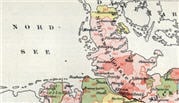Source Information

-Registre de l'etat civil pour la Commune de Lubeck, 17.Okt.-31.Dez. 1811
-Registre de l'etat civil pour la Mairie de Lubeck, pour l'an 1812-1813. Naissances
-Proklamationen, 1813-1871. Microfilm nos. 6069-6079, 6082-6084, 6087-6101.
About Lübeck, Germany, Births, 1811-1875
About this collection
This collection contains birth records from Lübeck covering the years 1811 up to and including 1875. The Hanseatic City of Lübeck is an independent city situated on the Trave River near the Baltic Sea, about 40 miles from Hamburg in the state of Schleswig-Holstein. It was one of the most important cities of the Hanseatic League in the Middle Ages. Lübeck is known for its medieval landmark, the Holsten Gate and as a producer of marzipan. It was the implied setting of Thomas Mann's novel, “Buddenbrooks.” Its well-preserved old town is a UNESCO World Heritage Site. Lübeck is known as "The City of Seven Towers" because of the Brick Gothic churches that dominate its skyline.
For the first two years of the time period of this collection, Lübeck belonged to the French Empire. Afterwards it was a part of the German Confederation and, from 1871, the German Reich. The collection includes records from the city center, suburbs and rural communities that belonged to Lübeck.
Birth, marriage and death registers for Lübeck begin on August, 20 1811. These lists or "civil records" were maintained even after the end of the French period. They were finally replaced in 1876 when the German Reich introduced the Civil Registry. Occasionally, alphabetical directories of names were also created. While churches continued to keep traditional records, the State also mandated that the personal or marital status of the entire population be recorded.
What you can find in the records
For the years up to and including 1866, births were recorded in handwritten paragraphs according to a standard formula. Afterwards they were created using preprinted forms that were filled in by hand by the registrar. In each record the date of a birth usually differs from the date it was registered. Depending on the individual form or on the formulations used by the registrar, you may find:
- Sequential or Certificate Number
- Registration Date
- Informant: Occupation, Given Names, Last Name, Residence
- Mother: Given Names, Last Name, Maiden Name
- Child: Birth Date, Time of Birth, Sex, Given Names
- Signatures
More about using this collection
The images for both the handwritten documents and the later preprinted forms display two pages at a time, with multiple entries. The “Informant” in earlier documents was usually the child's father, later it is often a midwife.
Archiv der Hansestadt Lübeck makes available the following highly detailed publication on Lübeck's family history resources:
Kruse, Meike: Wo finde ich was? Handbuch zur Familien-, Personen- und Hausforschung im Archiv der Hansestadt Lübeck. In: Kleine Hefte zur Stadtgeschichte, Heft 18, Lübeck 2005.
 Need help with the German language?
Need help with the German language?